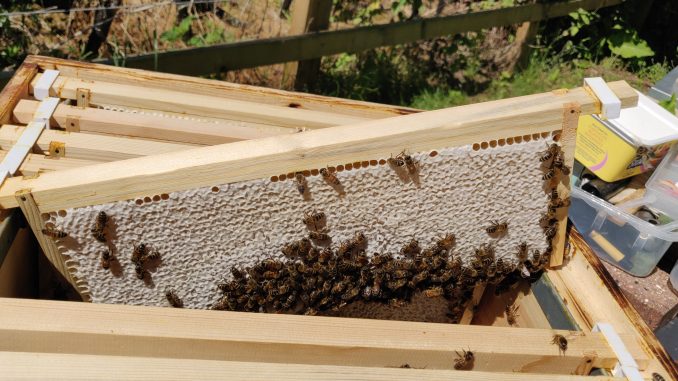
What a difference good weather makes for our bees. In my May notes we were enduring a very wet month and very little honey brought in. Now after a spell of warm weather bees have been very busy and supers are filling. Even though May was cold and wet bees made swarming preparations and, as soon as the weather improved, swarming started in earnest such that I was not able to artificially swarm all colonies that needed it.
This is where clipping a small part of a queen’s wing really helps. It doesn’t stop swarming but it can buy a few days grace. Clipped queens leave the hive but fall to the ground whilst the swarm settles somewhere nearby. When they realise the queen is not with them they either return to the hive or find the queen. She often makes her way under the floor of the hive so my first check is to look under the hives before carrying out inspections as I have found many swarms here.
On the topic of swarming I’m sure I read at some point that peak swarming time is when lupins are in full bloom. This was the case in my area this year and I shall watch lupins next year and be ready to carry out artificial swarming.
Carrying out an artificial swarm is a good time to introduce frames of foundation to replace old comb. However, bees are often reluctant to draw out these frames and sometimes they need to be ‘forced’. By this I mean placing one frame of foundation between frames of brood. This is all dependent on the prevailing conditions and the strength of the colony. So, if the following conditions are satisfied I will place a frame of foundation between each frame of brood:
a) Night time temperatures are warm – as they have been for the past couple of weeks.
b) The colony has built up strongly and there are plenty of bees to look after the brood.
c) There is a honey flow on thereby allowing bees to draw out the foundation.
Repeat the process if necessary 7 to 10 days later.
Some further thoughts on the above. I do not split frames of brood early in the season. The weather in April and May this year is a good case in point – it was far to cold so the brood needed to be kept together.
For me the colony is reasonably strong when there are a couple of supers or more with a lot of bees. Plenty of bees means they will come down from the supers to tend the brood if needed.
In my experience bees draw comb from ‘income’ and not ‘capital’. By this I mean that incoming nectar is used to produce wax rather than any honey that is stored in the supers or brood frames. If there isn’t a nectar flow it may be necessary to feed syrup but be careful if honey is present in the supers.
It is good practice for frames of foundation to be drawn during the summer so that they are ready for use when feeding starts. Bees are not very keen to draw frames later in the season which means they may not have enough drawn comb to store the syrup. They could then go into winter underweight which will result in problems for the colony later on.
A final thought. Now is a good time to make up nucs. The recent survey showed that a lot of people do not over winter nucs. Some beekeepers had heavy losses last winter so having a nuc or two is good insurance. Having used polynucs for a few years now I find that bees tend to do well in them. Bees transferred from a polynuc to a full hive in early spring can build up quickly and produce a good honey crop.
